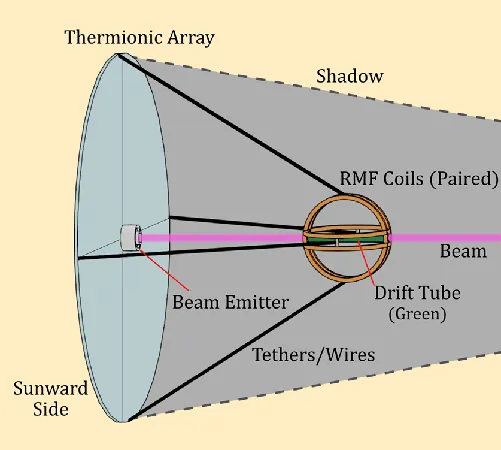
Breaking Boundaries: Pushing a Probe to Alpha Centauri Using Revolutionary Electromagnetic Beams
2025-01-06
Author: Siti
Introduction
Reaching another star system is a monumental challenge that has captured the imagination of scientists and dreamers alike. Among the leading efforts in this pursuit are Breakthrough Starshot and the Tau Zero Foundation, both exploring advanced propulsion systems that utilize beamed power. A recent groundbreaking paper authored by Jeffrey Greason, Chairman of the Tau Zero Foundation, and physicist Gerrit Bruhaug from Los Alamos National Laboratory sheds light on the potential of a relativistic electron beam to propel a spacecraft to Alpha Centauri.
Considering the Mass of the Spacecraft
One of the foremost considerations in deep-space missions is the mass of the spacecraft. Breakthrough Starshot's prototype features a diminutive design paired with expansive solar "sails," which harness light beams for acceleration. However, this minuscule spacecraft size raises concerns about its ability to collect substantial scientific data upon arrival—more an engineering marvel than a scientific instrument.
The Challenge of Larger Probes
Contrastingly, Greason and Bruhaug's study investigates a more substantial probe weighing up to 1000 kilograms, comparable to the Voyager spacecraft launched in the 1970s. Such a vessel would enable the inclusion of modern sensors and instruments capable of collecting valuable data. However, a significant challenge looms: the type of beam required to propel this larger probe.
Optical Technology Limitations
Breakthrough Starshot's strategy involves a laser beam in the visible spectrum that directly impinges on the spacecraft's light sails. Unfortunately, current optical technology limits the efficiency of such a beam to only about 0.1 Astronomical Units (AU) of the spacecraft's journey toward Alpha Centauri, which is a staggering distance of 277,000 AU. Though brief activation of the laser could theoretically achieve respectable interstellar speeds for a lightweight probe, the risk of damaging the craft remains a concern.
Innovative Solutions for Sustained Acceleration
The authors of the paper propose an innovative alternative: sustaining power over a more extended period, enabling greater force accumulation and enhanced acceleration for a robust probe. However, this approach presents its own challenges, notably beam coherence over vast distances. The study emphasizes the promise of utilizing relativistic electron beams in this mission concept, dubbed "Sunbeam."
Advantages of Relativistic Electron Beams
Relativistic electron beams carry several compelling advantages. Electrons can be accelerated to near-light speeds with relative ease compared to other particles. Additionally, while electrons repel one another due to their shared negative charge, this repulsion is mitigated at relativistic speeds through a phenomenon referred to as "relativistic pinch." This allows the electrons to remain closely packed, enhancing their collective propulsion power.
Potential Energy Delivery Range
The calculations presented in the paper indicate that a relativistic electron beam could effectively deliver energy out to 100 or even 1000 AU—far beyond the range of conventional propulsion methods. By the end of the beam's operational period, a 1000-kilogram probe could reach speeds of up to 10% of the speed of light, allowing it to arrive at Alpha Centauri in just over 40 years.
Overcoming Challenges of Power Generation
Nevertheless, formidable obstacles must be surmounted, including the challenge of generating a sufficiently powerful beam. The intensity of the beam needed increases with distance, with estimates indicating an energy requirement that could reach up to 19 gigaelectron volts at 100 AU—a tall order but within the realm of possibility with current technological capabilities, such as those demonstrated by the Large Hadron Collider.
The Solar Statite Concept
To harness this energy in the depths of space, the authors envision a theoretical system known as a solar statite. Positioned above the Sun’s surface, this platform would remain anchored using a combination of solar light pressure and magnetic fields, allowing it to transmit energy without succumbing to the Sun's gravitational pull. With the potential to withstand extreme temperatures akin to those encountered by the Parker Solar Probe, such a statite could effectively serve as an energy relay for the mission.
Ensuring Stable Energy Transmission
Crucially, the materialization of this beam would occur behind a massive sun shield, enabling operation within a stable, cooler environment. This static positioning would also ensure consistent energy delivery to the probe, free from interference from planetary bodies like Earth and the Sun.
Exploratory Nature of the Research
Although these concepts remain largely exploratory and are rooted in theoretical science, the collaboration on platforms like the ToughSF Discord server illustrates the vibrant intersection of science fiction and real-world propulsion research. The promising findings indicate that, with minimal advancements in current technologies, it might be feasible to push a scientifically viable probe to Alpha Centauri within a human lifetime.
Conclusion
This visionary research not only excites the field of space exploration but also ignites hope that interstellar travel could one day be a reality—a dream that has tantalized humanity for generations.


 Brasil (PT)
Brasil (PT)
 Canada (EN)
Canada (EN)
 Chile (ES)
Chile (ES)
 Česko (CS)
Česko (CS)
 대한민국 (KO)
대한민국 (KO)
 España (ES)
España (ES)
 France (FR)
France (FR)
 Hong Kong (EN)
Hong Kong (EN)
 Italia (IT)
Italia (IT)
 日本 (JA)
日本 (JA)
 Magyarország (HU)
Magyarország (HU)
 Norge (NO)
Norge (NO)
 Polska (PL)
Polska (PL)
 Schweiz (DE)
Schweiz (DE)
 Singapore (EN)
Singapore (EN)
 Sverige (SV)
Sverige (SV)
 Suomi (FI)
Suomi (FI)
 Türkiye (TR)
Türkiye (TR)
 الإمارات العربية المتحدة (AR)
الإمارات العربية المتحدة (AR)